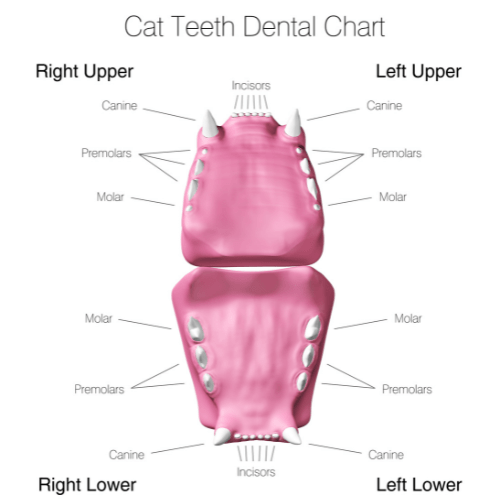Feline Dental Disease
Diseases of the teeth and gums are common in cats. Studies report that between 50 and 90% of cats older than four years of age suffer from some form of dental disease, but fortunately, the most common forms of these diseases are largely preventable or treatable with appropriate preventive dental care and monitoring.
Gingivitis
Gingivitis is a condition in which the gums around the teeth become inflamed (red, swollen, and painful). This inflammation is usually the result of a process that begins with the buildup of plaque, a film that harbors bacteria, on the teeth. If managed correctly Gingivitis is reversable.
SYMPTOMS
Red or swollen gums
Bad breath
Difficulty eating or not eating at all
Difficulty picking up toys
Drooling
Plaque build-up on the surface of teeth
Tartar
CAUSES OF GINGIVITIS
Bad dental care
Old age
Autoimmune diseases
Soft food
FelV (Feline Leukemia Virus)
Crowded teeth
PREVENTION
The best way to prevent gingivitis in cats is to regularly remove plaque buildup by tooth brushing. Some cats require gradual introduction before they will allow regular tooth brushing, most cats can eventually be trained to accept this preventive measure.
TREATMENT
Treatment of gingivitis involves removing accumulated plaque and dental calculus, then extracting loose or infected teeth to prevent further disease progression. Regular dental care and medical management are typically the first lines of treatment.
Periodontitis
If gingivitis is not controlled, it can progress to periodontitis, a condition that eventually cannot be reversed. In periodontitis, the tissues that attach the tooth to the underlying gums and bone are weakened as a result of damaging substances produced by disease-causing bacteria and the inflammation caused by the cat’s own immune system.
SYMPTOMS
Redness
Swelling
Bleeding
Difficulty eating or not eating at all
Difficulty picking up toys
Drooling
Develop halitosis
The recession of the Gingiva
Exposure of tooth root surfaces
In extreme cases, a cat may lose one or more teeth
CAUSES OF PERIODONTITIS
Cat periodontal disease can be caused by a variety of factors, but is most commonly associated with bacterial infection. Bacteria under the gumline lead to pain and inflammation of the tissue. There may also be a relationship between having a history of calicivirus infection and severe gingivitis.
TREATMENT
To treat feline periodontitis, your veterinarian will recommend removing plaque and mineral buildup by scaling and polishing the teeth while trying to save the teeth wherever possible. In extreme cases of periodontitis, extraction of teeth, sometimes of numerous teeth, may be required
Tooth Resorption
Tooth resorption is a process by which the dentin (a hard tissue that lies beneath the enamel of the tooth) in a tooth (or teeth) erodes and eventually becomes irreparably destroyed. Over time, all areas of an affected tooth may become involved.
SYMPTOMS
Eating food quickly as eating is painful
Eating on one side of the mouth
Drooling
Pawing at their face
Tooth loss
Weight loss
Bloody saliva
Swelling around the mouth and jaw
CAUSES – TOOTH RESORPTION
The exact cause of tooth resorption is still largely unknown. Some researchers suggest that infection or inflammation from periodontal disease may lead to the movement of odontoclastic cells into the area. Others maintain that diet plays a role in causing these lesions.
PREVENTION
The causes of tooth resorption in cats are not clear, and because of this, it is not possible to prevent it effectively. Regular dental checks with your vet are the best way to identify any issues early on, in order to avoid pain or discomfort.
TREATMENT
The best treatment for dental resorption is removing the affected tooth. This can be a complex procedure since the tooth is usually very fragile and can fracture. The vet may use dental x-rays to help find and remove fractured root fragments.
Removing the whole tooth is the only way to avoid infection and other issues.
Common Cat Dental Issues
TOOTH ROOT ABSCESSES
Lorem ipsum dolor sit amet, consectetur adipiscing elit, sed do eiusmod tempor incididunt ut labore et dolore magna aliqua. Ut enim ad minim veniam, quis nostrud exercitation.
BROKEN TEETH
Broken teeth tend to be very painful because the inside of each tooth contains a nerve. Once a tooth is damaged, infections and tooth root abscesses are much more likely so it’s often necessary to remove it.
RETAINED BABY TEETH
Your cat’s baby teeth should fall out by the time they reach 6 months of age. Retained baby teeth cause the mouth to become overcrowded, which means food and bacteria get trapped, leading to the build-up of plaque and tartar.
Prevention Is Key
Ways to care for your cat’s teeth and help prevent dental disease:
Brushing Teeth
Regular dental checks with your vet
Oral hygiene gels
Dental products and diets
If you require any help, support and advice regarding your cat’s oral hygiene we do have a dental nurse clinic available to discuss all your options with you.

